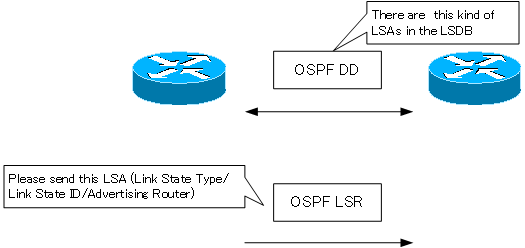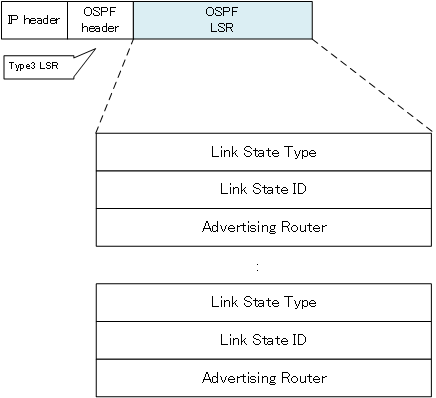Table of Contents
OSPF LSR(Link State Request) Packet
Request LSA by OSPF LSR packet. With DD packets, OSPF router recognize LSAs that are not in its own LSDB and newer LSAs. Then, it requests these LSAs by LSR. The LSA to be requested by LSR is identified by Link State Type, Link State ID and Advertising Router.

OSPF LSR Packet Format
Type 3 of the OSPF header indicates that it is an LSR packet; the format of LSR packet is as follows

Related article
The OSPF header is explained in the following article.
Link State Type(32bits)
Link State Type is a number that indicates the type of LSA. The following table summarizes the Link State Type values and LSA types.
| Link State Type Code | LSA Type |
| 1 | Router LSA |
| 2 | Network LSA |
| 3 | Network summary LSA |
| 4 | ASBR summary LSA |
| 5 | AS External LSA |
| 7 | NSSA External LSA |
Link State ID(32bits)
The Link State ID is contained in the LSA header, and what the Link State ID contains depends on the type of LSA. For example, for LSA type 1, the Link State ID is the router ID of the router that generated the LSA; for LSA type 2, the Link State ID is the IP address of the DR. Also, for LSA type 3, the Link State ID is the network address of another area.
Advertising Router(32 bits)
The router ID of the router that generated the LSA.
How the OSPF works
- OSPF Overview
- OSPF process flow
- OSPF Router ID : Identify OSPF routers
- What if the router ID of the OSPF router is duplicated?
- OSPF Neighbor and Adjacency
- OSPF DR/BDR
- How show ip ospf neighbor looks on Ethernet
- OSPF Network Type : Classification of OSPF-enabled interfaces
- Synchronization process of OSPF LSDB
- Problems with large-scale OSPF network
- OSPF Area – Inside the area, in detail; outside the area, just a summary
- OSPF Router Type
- OSPF LSA Type
- OSPF Area Type
- OSPF Basic Configuration and Verification Commands
- Details of enabling OSPF on the interface
- OSPF Advertising Loopback Interface
- Configuring and Verifying OSPF Hello/Dead interval
- OSPF Cost Configuration and Verification
- Configuring and Verifying OSPF Router Priority
- Configuring OSPF Neighbor Authentication
- Neighbor Authentication over Virtual-link
- OSPF Configuring and Verifying Stub area [Cisco]
- OSPF Stub Area Configuration Example [Cisco]
- OSPF default route generation : default-information originate command
- Configuration Example of OSPF default route generation : stub area
- OSPF Virtual-Link : Virtual area 0 point-to-point link
- Configuring and Verifying OSPF Virtual-link [Cisco]
- OSPF Virtual-link Configuration Example [Cisco]
- OSPF Virtual-link for discontinuous backbone configuration example
- OSPF Route Summary and Configuration
- Cisco OSPF Route Summary Configuration Example
- OSPF Route Type Preference
- Why the OSPF neighbor state gets stuck in Exstart?
- OSPF packet type and header format
- OSPF Hello Packet
- OSPF DD(Database Description) Packet
- OSPF LSR(Link State Request) Packet
- OSPF LSU(Link State Update) Packet
- OSPF LSAck(Link State Acknowledgement) Packet
- Limitation of OSPF redistribution routes – redistribute maximum-prefix command
- Overview of LSA Filters for OSPF – Filter LSA Type 3/Type 5
- Configuration example of LSA type 3 filter
- Configuration example of LSA type 5 filter
- OSPFv3 Configuration Example [Cisco]
- Configuration Example of OSPFv3 Route Summary [Cisco]
